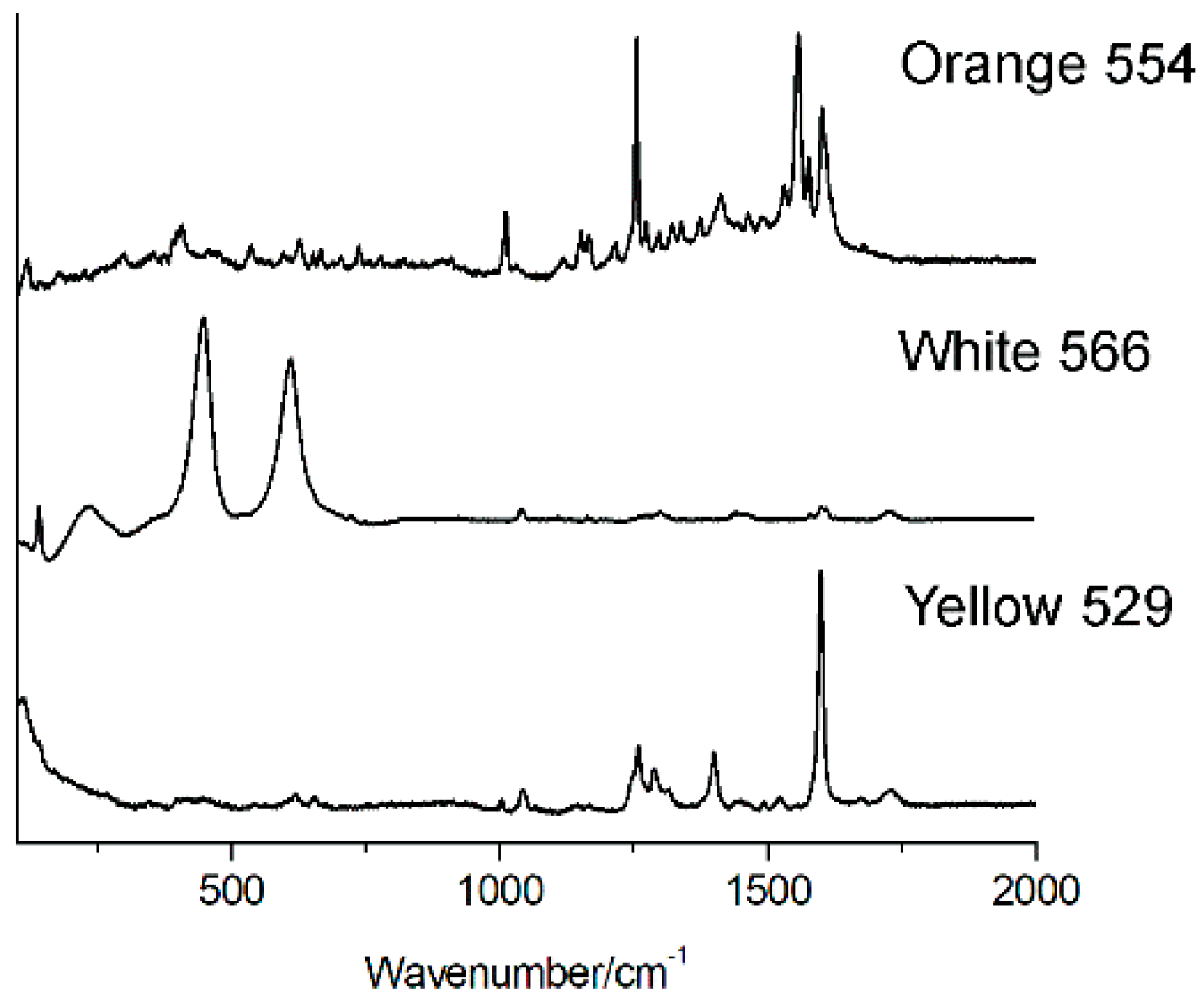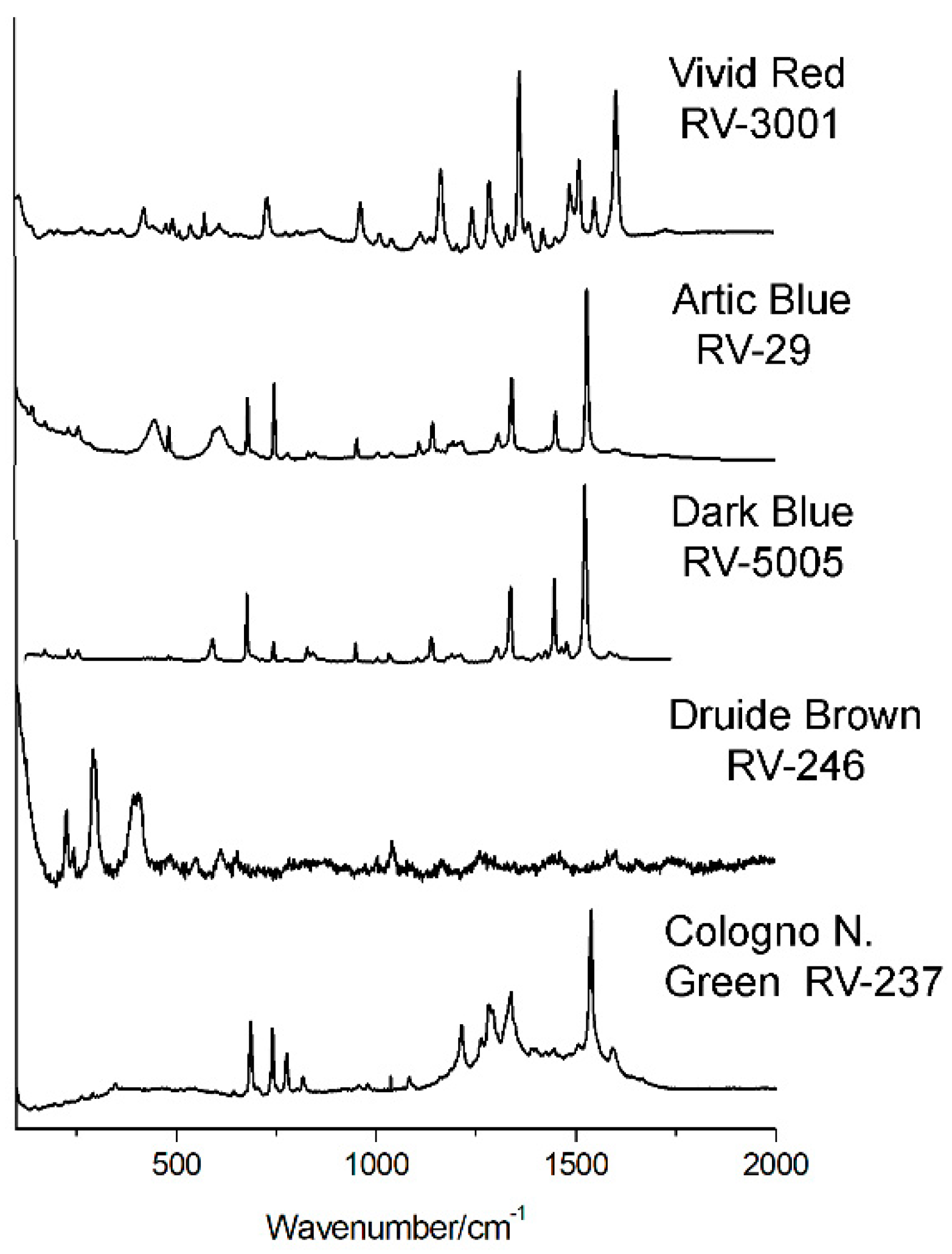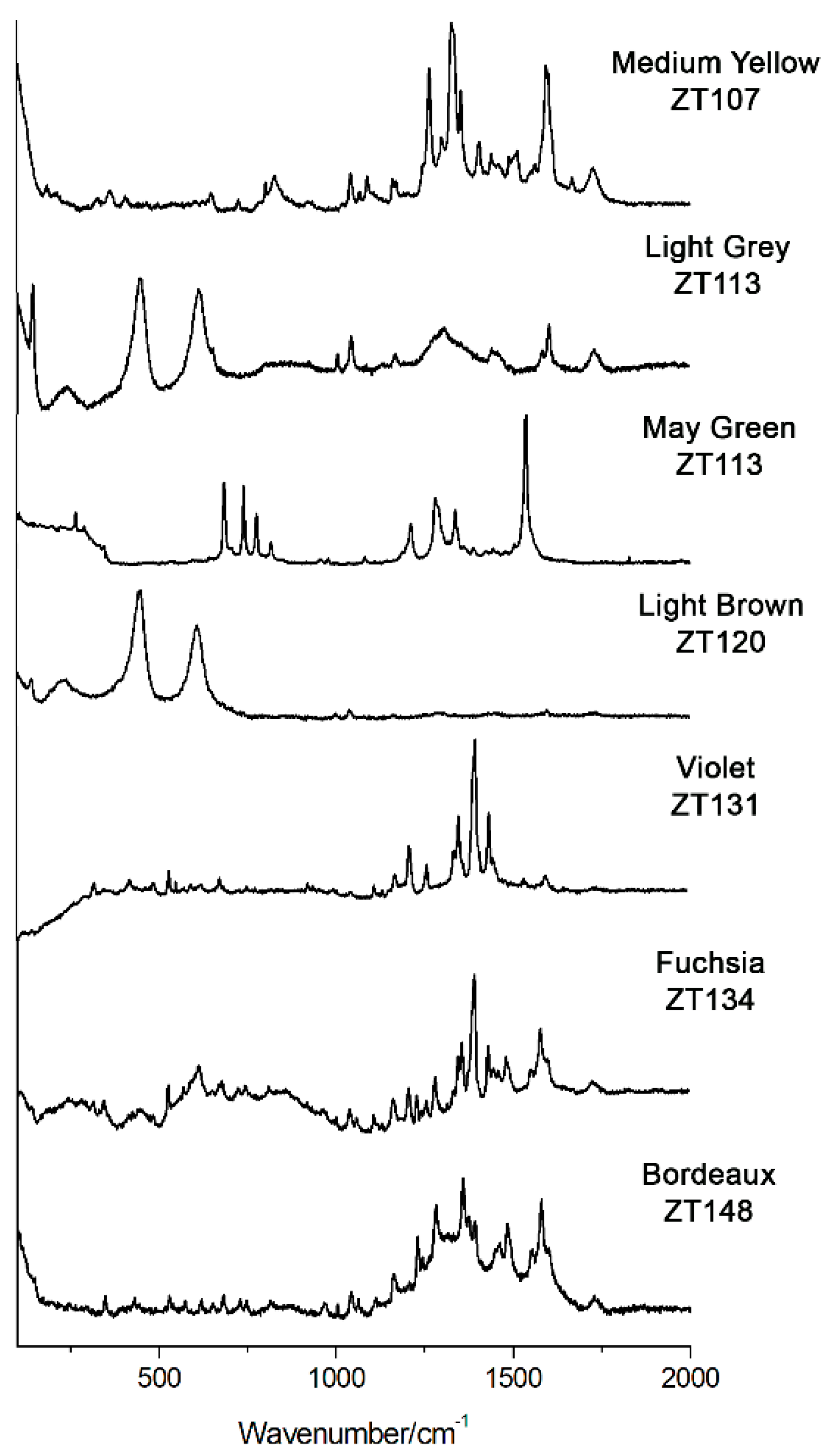Graffiti Characterization Prior to Intervention in the Punta Begoña Galleries (Getxo, North of Spain): Raman and XRF Spectroscopy in the Service of Restoration
Abstract
:1. Introduction
2. Materials and Methods
2.1. Commercial Sprays Analyses: Database
2.2. Sampling
2.3. Instrumentation
3. Results
3.1. Commercial Sprays
3.2. Inks Samples from the Main Hall
4. Conclusions
Supplementary Materials
Author Contributions
Funding
Institutional Review Board Statement
Informed Consent Statement
Acknowledgments
Conflicts of Interest
References
- Lama, E.; Prieto-Taboada, N.; Etxebarria, I.; Bermejo, J.; Castro, K.; Arana, G.; Rodrí-guez-Laso, M.D.; Madariaga, J.M. Spectroscopic characterization of xx century mural paintings of punta begoña’s galleries under conservation works. Microchem. J. 2021, 168, 106423. [Google Scholar] [CrossRef]
- Galerías Punta Begoña. Galerías Punta Begoña. 2019. Available online: https://puntabegona.getxo.eus/ (accessed on 17 July 2021).
- European Commission. Real Long-Term Working Conditions of Anti-Graffiti and Self-Cleaning Coatings for Their Imple-Mentation in the Protection of the European Cultural Heritage. 2017. Available online: https://cordis.europa.eu/project/id/622417/es (accessed on 17 July 2021).
- European Commission. Development of a New Antigraffiti System, Based on Traditional Concepts, Preventing Damage of Architectural Heritage Materials. 2012. Available online: https://cordis.europa.eu/project/id/513718/reporting/es (accessed on 17 July 2021).
- European Commission. InnovativE Anti-Graffiti Product for Application in the Cultural Heritage of Europe. 2012. Available online: https://cordis.europa.eu/project/id/513718/reporting (accessed on 17 July 2021).
- Gomes, V.; Dionísio, A.; Pozo-Antonio, J.S. Conservation strategies against graffiti vandalism on Cultural Heritage stones: Protective coatings and cleaning methods. Prog. Org. Coat. 2017, 113, 90–109. [Google Scholar] [CrossRef]
- Rivas, T.; Pozo, S.; Fiorucci, M.P.; López, A.J.; Ramil, A. Nd:YVO4 laser removal of graffiti from granite. Influence of paint and rock properties on cleaning efficacy. Appl. Surf. Sci. 2012, 263, 563–572. [Google Scholar] [CrossRef]
- Cortea, I.M.; Ratoiu, L.; Rădvan, R. Characterization of spray paints used in street art graffiti by a non-destructive multi-analytical approach. Color Res. Appl. 2021, 46, 183–194. [Google Scholar] [CrossRef]
- Germinario, G.; van der Werf, I.D.; Sabbatini, L. Chemical characterisation of spray paints by a multi-analytical (Py/GC–MS, FTIR, μ-Raman) approach. Microchem. J. 2016, 124, 929–939. [Google Scholar] [CrossRef]
- Sánchez Pons, M. Acercamiento a la evolución histórica y tecnológica de los materiales pictóricos empleados en el grafiti y arte urbano. GEC 2016, 10, 146–159. [Google Scholar] [CrossRef] [Green Version]
- Bosi, A.; Ciccola, A.; Serafini, I.; Guiso, M.; Ripanti, F.; Postorino, P.; Curini, R.; Bianco, A. Street art graffiti: Dis-covering their composition and alteration by FTIR and micro-Raman spectroscopy. Spectrochim. Acta A 2020, 225, 117474. [Google Scholar] [CrossRef] [PubMed]
- Caggiani, M.C.; Cosentino, A.; Mangone, A. Pigments Checker version 3.0, a handy set for conservation scientists: A free online Raman spectra database. Microchem. J. 2016, 129, 123–132. [Google Scholar] [CrossRef]
- Madariaga, J.M. Analytical chemistry in the field of cultural heritage. Anal. Methods 2015, 7, 4848–4876. [Google Scholar] [CrossRef]
- Madariaga, J.M. Analytical Strategies for Cultural Heritage Materials and their Degradation. R. Soc. Chem. 2021, P001. [Google Scholar] [CrossRef]
- Fremout, W.; Saverwyns, S. Identification of synthetic organic pigments: The role of a comprehensive digital Raman spectral library. J. Raman Spectrosc. 2012, 43, 1536–1544. [Google Scholar] [CrossRef]
- Infrared & Raman Users Group (IRUG). Spectral Database: Organic Dyes and Pigments. 2021. Available online: http://www.irug.org/search-spectral-database/spectra-index?sortHeader=data_type_raman (accessed on 17 July 2021).
- Noguera-Cámara, J.; Amor-García, R.L. Conservation Issues in Modern and Contemporary Murals; Sánchez, M., Shank, W., Fuster, L., Eds.; Cambridge Scholars Publishing: Cambridge, UK, 2015; pp. 166–183. [Google Scholar]
- Madariaga, I.; Lama, E.; Calparsoro, E.; Prieto-Taboada, N.; Arana, G.; Laso, M.D.R.; Madariaga, J.M. Enhancement and recovery of the tiles affected by atmospheric pollutants in the Galleries of Punta Begoña, Getxo (Bizkaia). Boletín Soc. Española Cerámica Vidr. 2019, 58, 161–170. [Google Scholar] [CrossRef]
- Dahlen, M.A. The Phthalocyanines A New Class of Synthetic Pigments and Dyes. Ind. Eng. Chem. 1939, 31, 839–847. [Google Scholar] [CrossRef]
- Scherrer, N.C.; Stefan, Z.; Francoise, D.; Annette, F.; Renate, K. Synthetic organic pigments of the 20th and 21st century relevant to artist’s paints: Raman spectra reference collection. Spectrochim. Acta A 2009, 73, 505–524. [Google Scholar] [CrossRef] [PubMed]
- Wiesinger, R.; Pagnin, L.; Anghelone, M.; Moretto, L.M.; Orsega, E.F.; Schreiner, M. Pigment and Binder Concen-trations in Modern Paint Samples Determined by IR and Raman Spectroscopy. Angew. Chem. Int. Ed. 2018, 57, 7401–7407. [Google Scholar] [CrossRef] [PubMed] [Green Version]
- Honzíček, J.; Matušková, E.; Voneš, Š.; Vinklárek, J. MaterialsHelmet Phthalocyaninato Iron Complex as a Primary Drier for Alkyd Paints. Materials 2021, 14, 1220. [Google Scholar] [CrossRef] [PubMed]
- García-Florentino, C.; Maguregui, M.; Morillas, H.; Balziskueta, U.; Azcarate, A.; Arana, G.; Madariaga, J.M. Port-able and Raman imaging usefulness to detect decaying on mortars from Punta Begoña Galleries (Getxo, North of Spain). J. Raman Spectrosc. 2016, 47, 1458–1466. [Google Scholar] [CrossRef]
- Prieto-Taboada, N.; Ibarrondo, I.; Gómez-Laserna, O.; Martinez-Arkarazo, I.; Olazabal, M.A.; Madariaga, J.M. Buildings as repositories of hazardous pollutants of anthropogenic origin. J. Hazard. Mater. 2013, 248–249, 451–460. [Google Scholar] [CrossRef] [PubMed]
- Buzzini, P.; Massonnet, G.; Sermier, F.M. The micro Raman analysis of paint evidence in criminalistics: Case studies. J. Raman Spectrosc. 2006, 37, 922–931. [Google Scholar] [CrossRef]
- Jaffe, E.E. Pigments, Organic. Kirk-Othmer Encyclopedia of Chemical Technology 2004.





| Brand | Pigment | Major Elements | Minor Elements |
|---|---|---|---|
| Titan | Orange (554) | Ti, Fe, Cl | Zn, Pb, Co, Zr, Ca |
| White (566) | Ti | − | |
| Yellow (529) | Ti, Fe | Ca, Zr, Co, Cl, Zn | |
| Montana | Vivid Red (RV-3001) | Ti, Fe | Ca, Co, Zr, Zn |
| Artic Blue (RV-29) | Ti | − | |
| Dark Blue (RV-5005) | Ti, Cu | Si, Ca, Fe | |
| Druid Brown (RV-246) | Ti, Fe | Zr | |
| Cologno N. Green (RV-237) | Ti, Fe | Cl, Ca, Cu, Si, Zr, Co | |
| Decor Pintura | Medium Yellow (ZT107) | Bi, V | Zr, Co, Zn, Ca, Ti, Cl |
| Light Grey (ZT113) | Ti | Fe, Si, Zr, Ca | |
| May Green (ZT129) | Cl, Cu, Zr, Ca | Ti, Fe, Co | |
| Light Brown (ZT120) | Fe | Zr, Si, Zn, Ca, Co | |
| Violet (ZT131) | Ti, Fe, Zr | Ca, Co, Zn | |
| Fuchsia (ZT134) | Ti | Fe, Zr, Cl, Co, Ca, Cr | |
| Bordeaux (ZT148) | Cl, Fe, Ca, Si, Zr | Co, Ti, Zn |
| Brand | Pigment | Composition | Raman Bands |
|---|---|---|---|
| Titan | Orange (554) | Pyrazoloquinazolone (PO67) | 121, 226, 407, 546, 627, 652, 666, 738, 1012s, 1117, 1154, 1166, 1216, 1256 s, 1274, 1298, 1322, 1340, 1374, 1413, 1532, 1558 s, 1577, 1603 s cm−1 |
| White (566) | Titanium oxide (Rutile) | 143, 234, 449 s, 612 s cm−1 | |
| Alkyd binder Binder | 1044, 1168, 1302, 1447, 1582, 1602, 1725 cm−1 | ||
| Yellow (529) | Diarylide (PY13) | 620, 656, 1146, 1259 s, 1288 s, 1401 s, 1450, 1493, 1526, 1600 vs cm−1 | |
| Alkyd binder, most likely CHS-Alkyd S 471 | 1004,1044, 1166, 1727 cm−1 | ||
| Montana | Vivid Red (RV-3001) | Naphthol AS (PR170) | 112, 193, 208, 267, 292, 335, 364, 423, 478, 494, 511, 539, 574, 611, 732 s, 778, 806, 866, 963 s, 1013, 1043, 1117, 1141, 1167 s, 1208, 1245, 1288 s, 1334, 1364 vs, 1386, 1423, 1454, 1489, 1513 s, 1552, 1606 vs cm−1 |
| Alkyd binder, most likely CHS-Alkyd S 471 | 1002, 1043, 1725 cm−1 | ||
| Artic Blue (RV-29) | Phthalocyanine (PB15) | 175, 234, 258, 484, 681 s,748 s, 782, 833, 849, 955, 1110, 1145, 1196, 1218, 1309, 1344 s, 1453, 1530 vs, 1602 cm−1 | |
| Titanium oxide (Rutile) | 142, 234, 447 s, 610 s cm−1 | ||
| Alkyd binder | 1008, 1042, 1731 cm−1 | ||
| Dark Blue (RV-5005) | Phthalocyanine (PB15) | 176, 235, 259, 483, 483, 595, 681 s, 719, 747, 832, 847, 954, 1038, 1108, 1144, 1194, 1216, 1307, 1342 s, 1412, 1452 s, 1470, 1483, 1529 vs, 1590 cm−1 | |
| Druid Brown (RV-246) | Hematite | 226, 244, 292 s, 404 s, 484, 610 cm−1 | |
| Goethite | 392, 549 cm−1 | ||
| Alkyd binder, most likely CHS-Alkyd S 471 | 652, 1004, 1040, 1578, 1601 cm−1 | ||
| Cologno N. Green (RV-237) | Phthalocyanine (PG7) | 194, 234, 266, 598, 641, 684, 740, 775, 818, 951, 975, 1212, 1261, 1282, 1292, 1337, 1504, 1537, 1590 cm−1 | |
| Decor Pintura | Medium Yellow (ZT107) | Acetoacetic arylide (PY74) | 186, 329, 363, 406, 648, 803, 829, 923, 1068, 1090, 1161, 1171, 1265, 1299, 1327, 1354, 1406, 1440, 1491, 1514, 1563, 1595, 1669 cm−1 |
| Alkyd binder | 726, 1043, 1727 cm−1 | ||
| Light Grey (ZT113) | Titanium white | 144, 233, 444 s, 611 s cm−1 | |
| Alkyd binder, most likely CHS-Alkyd S 471 | 1005, 1043, 1303, 1439, 1602, 1728 cm−1 | ||
| May Green (ZT129) | Phthalocyanine (PG7) | 148, 165, 198, 223, 266, 291, 333, 347, 546, 594, 643, 685 s, 740 s, 776 s, 817, 956, 979, 1083, 1213 s, 1282 s, 1338 s, 1388, 1445, 1538 vs. cm−1 | |
| Light Brown (ZT120) | Hematite | 226, 246, 293, 411, 610, 1300 cm−1 | |
| Goethite | 387, 549 cm−1 | ||
| Alkyd binder, most likely CHS-Alkyd S 471 | 1005, 1042, 1444, 1583, 1602, 1724 cm−1 | ||
| Violet (ZT131) | Dioxazine (PV23) | 317, 416, 484, 528 s, 591, 672, 724, 748, 921, 934, 990, 1108, 1122, 1131, 1152, 1167, 1208 s, 1258 s, 1334 s, 1348 s, 1394 vs, 1433 s, 1445, 1593 cm−1 | |
| Alkyd binder, most likely CHS-Alkyd S 471 | 1003, 1042 cm−1 | ||
| Fuchsia (ZT134) | Dioxazine (PV23) | 317, 485, 529, 592, 614, 681, 726, 746, 812, 922, 935, 1110, 1133, 1165, 1208, 1260, 1335, 1349, 1394 s, 1433, 1447, 1461, 1581 s cm−1 | |
| Alkyd binder, most likely CHS-Alkyd S 471 | 1004, 1042, 1601, 1726 cm−1 | ||
| Unidentified | 347, 442, 1062, 1231, 1284, 1359, 1484, 1553 cm−1 | ||
| Bordeaux (ZT148) | Naphthol AS (PR112) | 348, 431, 529, 575, 620, 682, 720, 747, 814, 967, 1063, 1163, 1231, 1245, 1358, 1375, 1393, 1403, 1485, 1555, 1581 cm−1 | |
| Alkyd binder | 651, 1004, 1729 cm−1 |
| Name | Major Elements | Minor Elements |
|---|---|---|
| (T1) Light Red | Ca, S | Fe, Ti, Pb |
| (T2) Light Green | Ti, Ca | S, Fe, Pb, Si, Zr |
| (T3) Dark Yellow | Ca, Fe, S | Ti |
| (T4) Light Blue | Ti, Ca, Fe | S, Pb, Bi, Si, K |
| (T5) Light Orange | Ca, Fe, Ti | S, Pb, K, Si |
| (T6) Dark Blue | Ti, S, Ca | Pb, Fe, Cu |
| (T7) White | Ti, Ca | Fe, Si, S |
| (T8) Bone White | Ti, Fe | Cu, Ca, S, Zr |
| (T9) Ochre | Fe, Ca, S, Ti | Cu, Pb |
| (T10) Dark Green | Ca, Ti, Fe, S | Cl, Si Cu, Pb, K |
| (T11) Purple | Ti, Fe, Ca | S, Bi, Si, Mn, Zn |
| (T12) Light Yellow | Ti, Fe | Ca, S, Si, As |
| Name | Composition | Raman Bands |
|---|---|---|
| (T1) Light Red | Lead molybdate chromate (PR104) | 151, 337, 357, 823 s, 849 sh cm−1 |
| (T2) Light Green | Acetoacetic arylide (PY74) | 187, 224, 260, 319, 361, 404, 465, 524, 601, 624, 646, 802, 846, 917, 1018, 1067, 1089, 1160, 1171, 1264 s, 1299, 1327 vs, 1353 s, 1404, 1423, 1439, 1459, 1512, 1551, 1593 s, 1668 cm−1 |
| (T3) Dark Yellow | Acetoacetic arylide (PY74) | 186, 260, 359, 402, 464, 524, 601, 623, 646, 742, 802, 846, 917, 1017, 1066, 1089, 1160, 1170, 1263 s, 1298, 1327 vs, 1352 s, 1403, 1423, 1439, 1459, 1490, 1511, 1551, 1593 s, 1668 cm−1 |
| Goethite | 301, 387, 549 cm−1 | |
| (T4) Light Blue | Phthalocyanine (PB15) | 290, 483, 596, 642, 682 s, 719, 748v s, 782, 834, 846, 954, 1009, 1110, 1144 s, 1197, 1210, 1307, 1342, 1451, 1529 vs cm−1 |
| (T5) Light Orange | Disazo pyrazolone (PO34) | 294, 369, 392, 539, 669, 768, 915, 1048, 1159, 1188, 1237, 1273, 1289, 1298, 1422, 1475, 1537, 1598 vs, 1654 cm−1 |
| Acetoacetic arylide (PY74) | 186, 224, 259, 358, 403, 600, 322, 645, 801, 953, 1018, 1089, 1124, 1159, 1263, 1298, 1327 vs, 1351, 1404, 1438, 1498, 1511, 1598 s, 1666 cm−1 | |
| (T6) Dark Blue | Phthalocyanine (PB15) | 290 vw, 483, 594, 643vw, 680 s, 715vw, 748 s, 780, 834, 855, 954, 1008 vw, 1108, 1144, 1195, 1307, 1342 s, 1450, 1529 vs cm−1 |
| (T7) White | Titanium white | 448, 606 cm−1 |
| Alkyd binder | 999, 1042, 1172, 1308, 1599 cm−1 (very weak) | |
| (T8) Bone White | Acetoacetic arylide (PY74) | 186, 264, 314, 359, 404, 645, 802, 827, 915, 953, 1018, 1066, 1090, 1125, 1160, 1263 vs, 1300, 1331 vs, 1351 vs, 1403, 1511, 1549, 1592 vs, 1637, 1667 cm−1 |
| Titanium white | 447 s, 612 s cm−1 | |
| Alkyd binder | 1003 cm−1 (very weak) | |
| (T9) Ochre | Acetoacetic arylide (PY74) | 187, 359, 403, 465, 601, 624, 646, 802, 916, 1018, 1067, 1089, 1160, 1171, 1264 s, 1298, 1327 vs, 1353 s, 1404, 1423, 1439, 1460, 1490, 1512 s, 1552, 1593 s, 1668 cm−1 |
| Goethite | 385 cm−1 | |
| (T10) Dark Green | Phthalocyanine (PG7) | 100, 224, 685 s, 740 s, 774 s, 817, 959, 1080, 1212 s, 1281 s, 1337 s, 1535 vs cm−1 |
| (T11) Purple | Bona (PR48 Na or PR48:2 Ca) | 350, 412, 493, 532, 572, 601, 717, 748, 972, 1040, 1104, 1113, 1177, 1236, 1236, 1263, 1323, 1361, 1375, 1387, 1454, 1473, 1486, 1557, 1596 cm−1 |
| (T12) Light Yellow | Phthalocyanine (PG7) | 100, 264, 292, 684, 740, 773, 956, 1081, 1209, 1277,1337, 1442, 1529 s cm−1 |
Publisher’s Note: MDPI stays neutral with regard to jurisdictional claims in published maps and institutional affiliations. |
© 2021 by the authors. Licensee MDPI, Basel, Switzerland. This article is an open access article distributed under the terms and conditions of the Creative Commons Attribution (CC BY) license (https://creativecommons.org/licenses/by/4.0/).
Share and Cite
Etxebarria, I.; Prieto-Taboada, N.; Lama, E.; Arana, G.; Rodríguez-Laso, M.D.; Madariaga, J.M. Graffiti Characterization Prior to Intervention in the Punta Begoña Galleries (Getxo, North of Spain): Raman and XRF Spectroscopy in the Service of Restoration. Appl. Sci. 2021, 11, 8640. https://doi.org/10.3390/app11188640
Etxebarria I, Prieto-Taboada N, Lama E, Arana G, Rodríguez-Laso MD, Madariaga JM. Graffiti Characterization Prior to Intervention in the Punta Begoña Galleries (Getxo, North of Spain): Raman and XRF Spectroscopy in the Service of Restoration. Applied Sciences. 2021; 11(18):8640. https://doi.org/10.3390/app11188640
Chicago/Turabian StyleEtxebarria, Idoia, Nagore Prieto-Taboada, Estibaliz Lama, Gorka Arana, María Dolores Rodríguez-Laso, and Juan Manuel Madariaga. 2021. "Graffiti Characterization Prior to Intervention in the Punta Begoña Galleries (Getxo, North of Spain): Raman and XRF Spectroscopy in the Service of Restoration" Applied Sciences 11, no. 18: 8640. https://doi.org/10.3390/app11188640






